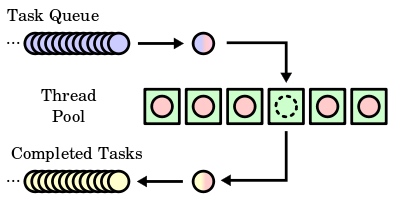C++实现简单的线程池
启动优化中,尽量能不在主线程就不在主线程。放到子线程又尽量不要密集并发,挨个来,给主线程多一些执行机会。那么一种方法是使用线程池。
介绍
这是Wikipedia上的定义:
In computer programming, a thread pool is a software design pattern for achieving concurrency of execution in a computer program. Often also called a replicated workers or worker-crew model,[1] a thread pool maintains multiple threads waiting for tasks to be allocated for concurrent execution by the supervising program. By maintaining a pool of threads, the model increases performance and avoids latency in execution due to frequent creation and destruction of threads for short-lived tasks.[2] The number of available threads is tuned to the computing resources available to the program, such as parallel processors, cores, memory, and network sockets.[3]
一种线程使用模式。线程过多会带来调度开销,进而影响缓存局部性和整体性能。而线程池维护着多个线程,等待着监督管理者分配可并发执行的任务。这避免了在处理短时间任务时创建与销毁线程的代价。线程池不仅能够保证内核的充分利用,还能防止过分调度。可用线程数量应该取决于可用的并发处理器、处理器内核、内存、网络sockets等的数量。 例如,线程数一般取cpu数量+2比较合适,线程数过多会导致额外的线程切换开销。
- 英文 https://en.wikipedia.org/wiki/Thread_pool
- 中文 https://zh.wikipedia.org/wiki/%E7%BA%BF%E7%A8%8B%E6%B1%A0
如图:

实现
这篇2012年的文章 http://progsch.net/wordpress/?p=81 讲了一种简单的实现,是使用 C++11 实现的。下面的实现在这篇文章的代码上稍微进行了一点优化。
直接放代码了。
ThreadPool.h
#include <thread>
#include <mutex>
#include <condition_variable>
#include <queue>
class ThreadPool {
public:
ThreadPool(size_t);
template<class F>
void enqueue(F f);
~ThreadPool();
private:
void Task();
// need to keep track of threads so we can join them
std::vector< std::thread > workers;
// the task queue
std::deque< std::function<void()> > tasks;
// synchronization
std::mutex queue_mutex;
std::condition_variable condition;
bool stop;
};
// add new work item to the pool
template<class F>
void ThreadPool::enqueue(F f)
{
{ // acquire lock
std::unique_lock<std::mutex> lock(queue_mutex);
// add the task
tasks.push_back(std::function<void()>(f));
} // release lock
// wake up one thread
condition.notify_one();
}
ThreadPool.mm
#import "ThreadPool.h"
void ThreadPool::Task()
{
std::function<void()> task;
while(true)
{
{ // acquire lock
std::unique_lock<std::mutex>
lock(this->queue_mutex);
// look for a work item
while(!this->stop && this->tasks.empty())
{ // if there are none wait for notification
this->condition.wait(lock);
}
if(this->stop) // exit if the pool is stopped
return;
// get the task from the queue
task = this->tasks.front();
this->tasks.pop_front();
} // release lock
// execute the task
task();
}
}
// the constructor just launches some amount of workers
ThreadPool::ThreadPool(size_t threads)
: stop(false)
{
for(size_t i = 0;i<threads;++i){
workers.push_back(std::thread([this]{this->Task();}));
}
}
// the destructor joins all threads
ThreadPool::~ThreadPool()
{
// stop all threads
stop = true;
condition.notify_all();
// join them
for(size_t i = 0;i<workers.size();++i){
workers[i].join();
}
}
使用方法
参考代码位置:https://github.com/everettjf/Yolo/tree/master/BukuzaoArchive/sample/ThreadPoolSample
ThreadPool pool(2);
pool.enqueue([]{
// todo: workload
});
测试代码如下:
static ThreadPool pool(2);
NSInteger idx = 0;
pool.enqueue([idx]{ NSLog(@"begin%@",@(idx)); sleep(arc4random() % 10); NSLog(@"end%@",@(idx)); }); idx++;
pool.enqueue([idx]{ NSLog(@"begin%@",@(idx)); sleep(arc4random() % 10); NSLog(@"end%@",@(idx)); }); idx++;
pool.enqueue([idx]{ NSLog(@"begin%@",@(idx)); sleep(arc4random() % 10); NSLog(@"end%@",@(idx)); }); idx++;
pool.enqueue([idx]{ NSLog(@"begin%@",@(idx)); sleep(arc4random() % 10); NSLog(@"end%@",@(idx)); }); idx++;
pool.enqueue([idx]{ NSLog(@"begin%@",@(idx)); sleep(arc4random() % 10); NSLog(@"end%@",@(idx)); }); idx++;
pool.enqueue([idx]{ NSLog(@"begin%@",@(idx)); sleep(arc4random() % 10); NSLog(@"end%@",@(idx)); }); idx++;
pool.enqueue([idx]{ NSLog(@"begin%@",@(idx)); sleep(arc4random() % 10); NSLog(@"end%@",@(idx)); }); idx++;
pool.enqueue([idx]{ NSLog(@"begin%@",@(idx)); sleep(arc4random() % 10); NSLog(@"end%@",@(idx)); }); idx++;
其他
iOS上有多种线程创建方法,上面只是一种C++的实现。GitHub还有其他简单的实现:
欢迎关注订阅号「客户端技术评论」:
